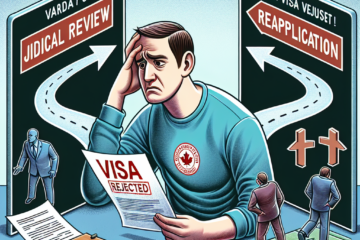The case of Shafei v. Canada, 2025 FC 147, has garnered significant attention for its complex legal arguments and the implications of its ruling. As the Federal Court of Canada deliberated on this case, it explored vital issues concerning immigration law, individual rights, and governmental responsibilities. This article aims to provide a comprehensive overview of the case, examining the legal arguments presented by Shafei, the defense mounted by Canada, and the court’s ultimate decision and its broader implications.
Table of contents
Overview of the Shafei v. Canada Case
The Shafei v. Canada case emerged from a dispute involving Mr. Amir Shafei, an Iranian national seeking asylum in Canada due to fears of persecution in his home country. Shafei arrived in Canada in 2023 and filed a refugee claim, citing his political activism and affiliation with a banned organization in Iran as the basis for his claim. The Canadian Immigration and Refugee Board (IRB) initially rejected Shafei’s claim, leading him to seek judicial review in the Federal Court.
The case centered around the IRB’s assessment of Shafei’s credibility and the perceived inconsistencies in his testimony. The IRB had concluded that Shafei’s narrative was not sufficiently credible to warrant protection under Canada’s refugee protection framework. In response, Shafei’s legal team argued that the IRB had erred in its decision-making process, failing to account for the inherent challenges faced by asylum seekers in providing consistent testimonies.
The Federal Court’s task was to evaluate whether the IRB’s decision was reasonable and whether it had adhered to the principles of natural justice. Shafei’s legal team contended that the IRB’s approach was overly rigid, lacking the flexibility required to accommodate the complexities of refugee claims. The case thus presented an opportunity for the court to clarify the standards and procedures applicable to refugee determinations in Canada.
As the case unfolded, it highlighted the broader issues of refugee protection and the balance between national security concerns and individual rights. The court’s decision was anticipated to set a precedent for future cases involving similar circumstances, potentially influencing how refugee claims are assessed in Canada.
Legal Arguments Presented by Shafei
Shafei’s legal team advanced several key arguments to challenge the IRB’s decision. Central to their case was the assertion that the IRB had failed to apply the principle of “benefit of the doubt,” which is crucial in cases where claimants face difficulties in providing corroborative evidence due to their circumstances. They argued that Shafei’s inconsistencies should not have been viewed as definitive proof of incredibility but rather as a reflection of the traumatic experiences he had endured.
Additionally, Shafei’s lawyers contended that the IRB had not adequately considered the country conditions in Iran, particularly the risks faced by political dissidents. They argued that the IRB’s analysis lacked depth and failed to account for the evolving political climate in Iran, which could exacerbate the dangers faced by individuals like Shafei if they were forced to return.
Another argument focused on the procedural fairness of the IRB’s decision-making process. Shafei’s team claimed that he had not been given an adequate opportunity to address the inconsistencies identified in his testimony. They asserted that the IRB had relied too heavily on minor discrepancies without providing Shafei with a chance to explain or contextualize them.
Lastly, Shafei’s lawyers emphasized the importance of considering the psychological impact of trauma on asylum seekers. They argued that the IRB should have taken into account the psychological scars and memory issues that often accompany individuals fleeing persecution, which could contribute to inconsistencies in their accounts.
Canada’s Defense and Legal Justifications
In response to Shafei’s claims, the Canadian government defended the IRB’s decision by asserting that the board had conducted a thorough and reasonable assessment of the case. Canada’s legal representatives emphasized the IRB’s mandate to ensure that refugee protection is granted only to those who genuinely qualify, and they argued that the board had acted within its discretion in rejecting Shafei’s claim.
The government highlighted the importance of maintaining the integrity of Canada’s refugee system, which requires rigorous scrutiny of claims to prevent abuse. They contended that the IRB had appropriately applied the legal standards for assessing credibility and that its conclusions were supported by the evidence available. Canada’s representatives argued that the inconsistencies in Shafei’s testimony were significant enough to undermine his overall credibility.
Furthermore, Canada’s defense stressed that the IRB’s decision was based on a comprehensive evaluation of both the evidence presented and the prevailing conditions in Iran. They argued that the board had considered relevant country reports and expert testimony to assess the risks associated with Shafei’s return to Iran, concluding that the level of risk did not meet the threshold for refugee protection.
Lastly, the government underscored the procedural fairness of the IRB’s process, asserting that Shafei had been given ample opportunity to present his case and respond to concerns raised during the hearings. They argued that the IRB had adhered to established protocols and that its decision was both reasonable and justified based on the information before it.
Court’s Ruling and Its Implications
The Federal Court ultimately ruled in favor of Shafei, finding that the IRB’s decision was unreasonable and that it had failed to adequately consider the evidence and circumstances of the case. The court emphasized the need for a more nuanced approach to credibility assessments, particularly in cases involving asylum seekers who may struggle to provide consistent testimonies due to their traumatic experiences.
In its ruling, the court highlighted the importance of the “benefit of the doubt” principle in refugee determinations, underscoring that minor inconsistencies should not automatically negate a claimant’s credibility. The decision called for a more empathetic and context-sensitive evaluation of refugee claims, recognizing the unique challenges faced by individuals fleeing persecution.
The court’s decision also had significant implications for the assessment of country conditions in refugee cases. It underscored the need for decision-makers to conduct thorough and up-to-date analyses of the political and social landscapes in claimants’ home countries. This aspect of the ruling reinforced the importance of considering evolving risks and the potential for increased danger upon return.
The ruling in Shafei v. Canada is expected to influence future refugee determinations in Canada, prompting the IRB and other adjudicative bodies to adopt more flexible and considerate approaches in their assessments. It serves as a reminder of the delicate balance between safeguarding national security and upholding Canada’s commitment to protecting vulnerable individuals seeking refuge.
The Shafei v. Canada case stands as a pivotal moment in Canadian immigration law, highlighting the complexities and challenges inherent in refugee determinations. The Federal Court’s decision not only provided relief for Mr. Shafei but also set an important precedent for how similar cases will be approached in the future. By emphasizing the need for a compassionate and context-aware evaluation of asylum claims, the court has reinforced Canada’s commitment to upholding the rights of individuals seeking protection from persecution. As the implications of this ruling continue to unfold, it will undoubtedly shape the landscape of refugee protection in Canada for years to come.



0 Comments